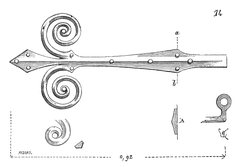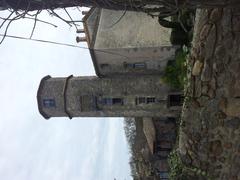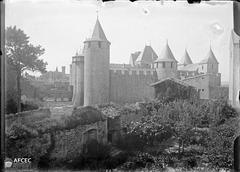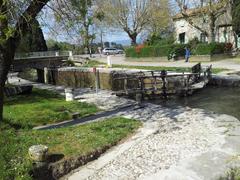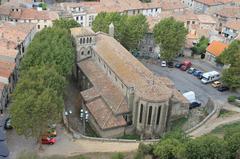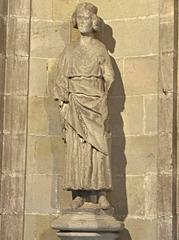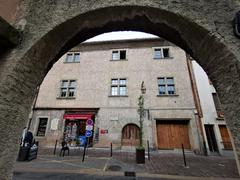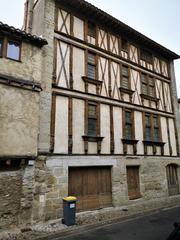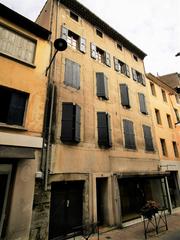Bastion De Montmorency Visiting Hours, Tickets, and Travel Guide – Carcassonne Historical Sites
Date: 14/06/2025
Introduction
Situated in the heart of Carcassonne’s Bastide Saint-Louis, the Bastion de Montmorency stands as a remarkable testament to the city’s evolution from medieval stronghold to Renaissance bastion. This historic fortification, often overshadowed by the famed Cité de Carcassonne, is an essential site for those seeking a deeper, more nuanced understanding of Carcassonne’s military, architectural, and cultural history. Built in the late 16th century during the Wars of Religion, the bastion exemplifies the adaptation of urban defenses to new artillery technologies and the transition from medieval to early modern fortification design. Though privately owned and not always open to the public, its exterior can be admired year-round, and special events occasionally allow interior visits.
This detailed guide covers everything you need to know about the Bastion de Montmorency: its history, architectural features, cultural importance, practical visitor information—including visiting hours and ticketing—accessibility, nearby attractions, and travel tips. Whether you are a history enthusiast, an architecture lover, or a curious traveler, this guide will help you appreciate why the Bastion de Montmorency is a must-see among Carcassonne’s historical sites. For the latest updates and additional resources, consult the Carcassonne Tourist Office and the Monumentum database.
Table of Contents
- Introduction
- Historical Background and Military Role
- Architectural Features
- Cultural Significance and Heritage Value
- Visiting the Bastion de Montmorency
- Practical Visitor Information
- Nearby Attractions & Events
- FAQs
- Conclusion
- References
Historical Background and Military Role
Early Fortifications and Strategic Importance
Carcassonne’s strategic hilltop location has been recognized since the Bronze Age, later serving as a Roman military hub due to the Via Aquitania (History Skills). The city’s defenses were continually enhanced by the Visigoths in the 5th century and expanded during the Middle Ages. The Bastion de Montmorency emerged from this centuries-long evolution, representing the city’s response to the growing threat of artillery warfare (History Tools).
Medieval Expansion and Albigensian Crusade
By the 12th and 13th centuries, Carcassonne was a Cathar stronghold and a focal point in the Albigensian Crusade. The city’s fortifications played a crucial defensive role during the 1209 siege, after which Carcassonne was annexed by the French crown and its defenses—eventually including the area of the future Bastion de Montmorency—were drastically reinforced (Armchair Traveler).
Renaissance Innovation
Constructed in the late 16th century, the Bastion de Montmorency is a response to the vulnerabilities exposed by gunpowder weaponry. Positioned at the southeast angle of the lower town’s ramparts, it is one of only two surviving bastions from the Renaissance-era upgrades to Bastide Saint-Louis (Monumentum).
Decline and Restoration
By the 17th century, changing military strategies and shifting borders reduced Carcassonne’s strategic importance. The city’s fortifications, including the bastion, fell into neglect. In the 19th century, famed architect Eugène Viollet-le-Duc led a restoration campaign, preserving Carcassonne’s fortifications and ensuring their survival into the present (History Tools).
Architectural Features
Bastion Design and Defensive Elements
The Bastion de Montmorency is a classic example of the “orillon” bastion, with rounded flanks designed to deflect artillery and protect defenders. Its solid stone construction and strategic placement at a vulnerable city angle were crucial in adapting to Renaissance-era siege tactics. The bastion once featured a counter-mine gallery for detecting enemy sappers (Monumentum).
Decorative and Structural Details
Unusually for a defensive structure, the bastion displays Renaissance decorative elements:
- South-facing façade with a niche and pediment.
- East-facing façade with two similar niches, framed by jambs and consoles.
- Traces of ornamental friezes (rinceaux) and colonnettes, now heavily eroded (Monumentum).
These features reflect the Renaissance tendency to blend military function with classical aesthetics, distinguishing the bastion from older, more austere medieval towers.
Integration with Urban Landscape
Located at 2 Boulevard Camille Pelletan, the bastion anchors the southeast corner of the Bastide Saint-Louis. It offers a rare physical link between the lower town’s vanished ramparts and Carcassonne’s broader history (Gralon).
Cultural Significance and Heritage Value
Monument Historique Status
The Bastion de Montmorency was designated a Monument Historique in 1948, safeguarding its preservation for future generations (Monumentum). While privately owned and not regularly open to the public, its exterior is freely viewable and occasionally accessible during special heritage events.
Educational and Community Value
The bastion is a focal point in Carcassonne’s local identity, providing educational opportunities and community engagement during events such as the European Heritage Days (TripSavvy). Its survival offers a tangible reminder of the city’s resilience and adaptability through centuries of conflict and change.
Visiting the Bastion de Montmorency
Location and Setting
- Address: 2 Boulevard Camille Pelletan / 1 Rue Voltaire, 11000 Carcassonne, France
- Nearest Landmarks: The Dôme, Pont Vieux, Bastide Saint-Louis (Gralon)
Visiting Hours
- Regular Access: The bastion is on private property and does not have standard public opening hours. The exterior is viewable at any time.
- Special Openings: Interior access is sometimes available during European Heritage Days (September) or other local events. Check with the Carcassonne Tourist Office for current schedule.
Tickets and Admission
- Exterior Viewing: Free; no ticket required.
- Interior Visits: No standard ticketing; access during special events may require advance sign-up or be limited to guided tours (Musique et Patrimoine de Carcassonne).
Access and Directions
- By Foot: A short walk from Place Carnot via Rue Voltaire or Boulevard Roumens.
- By Car: Nearby public parking at Gambetta or André Chénier (Gralon).
- By Public Transport: Local buses serve Bastide Saint-Louis; the main train station is about 10–15 minutes away on foot.
Accessibility
- The site is partially accessible. The terrain is uneven and lacks modern accessibility facilities. Interior access may be restricted for those with limited mobility.
What to Expect
The Bastion de Montmorency offers a serene, ivy-clad stone presence within a city block surrounded by 19th- and 20th-century buildings (Mescladis). Its weathered masonry and Renaissance details create a striking contrast with the urban environment. The bastion’s interior, when open, features a small arboretum.
Photography: The site provides excellent opportunities for capturing both architectural detail and atmospheric city views.
On-Site Interpretation: Minimal signage—research or a guided tour is recommended for deeper context. Apps such as GPSmyCity can supplement your visit.
Practical Tips for Visitors
- Best Season: Spring and autumn for pleasant weather; special events are often held in September.
- Duration: 15–30 minutes for the bastion itself; combine with a Bastide Saint-Louis walk for a half-day itinerary (Gralon).
- Respect Private Property: The bastion sits on retirement home grounds—be discreet and polite.
- No On-Site Facilities: Restrooms, cafés, and other amenities can be found nearby in the Bastide.
- Safety: Avoid climbing or exploring unstable areas; supervise children.
Nearby Attractions & Events
- Portail des Jacobins: Historic city gate.
- Place Carnot: Central square with cafés and shops.
- Jardin du Calvaire: Another surviving bastion, now a public garden.
- Pont Vieux: Picturesque bridge linking Bastide and Cité (SacaVoyage).
- Events: Bastide Saint-Louis hosts local markets and festivals year-round (Tourisme Carcassonne).
Frequently Asked Questions (FAQ)
Q: Are there set visiting hours for the Bastion de Montmorency?
A: The bastion is generally viewable from the street at any time but only open for interior visits during special events.
Q: Is there an entrance fee?
A: No; exterior viewing is free. Special event access may require sign-up.
Q: Is the site accessible for visitors with reduced mobility?
A: The exterior is partially accessible, but interior access is limited.
Q: Are guided tours available?
A: Occasionally, during special openings. Self-guided tours via mobile apps are also available.
Q: What other historical sites are nearby?
A: Portail des Jacobins, Place Carnot, Jardin du Calvaire, Pont Vieux, and the medieval Cité.
Conclusion
The Bastion de Montmorency offers a compelling and authentic perspective on Carcassonne’s layered past, from medieval fortresses to Renaissance innovations. While access to the interior is limited, the bastion’s architectural beauty and significance as a Monument Historique make it a rewarding stop for those seeking to go beyond the tourist routes. Plan your visit to coincide with heritage events for the fullest experience, and explore the surrounding Bastide Saint-Louis for a deeper connection to Carcassonne’s living history.
Stay informed on opening dates, accessibility, and local events with resources like the Carcassonne Tourist Office and the Monumentum database. Enhance your visit with the Audiala app for self-guided tours and interactive maps.
References
- History Skills: Carcassonne Classroom Resource
- History Tools: Carcassonne Fortress History
- Armchair Traveler: Carcassonne Fortress Evolution
- Monumentum: Bastion de Montmorency Carcassonne
- TripSavvy: Carcassonne Travel Guide
- Gralon: Bastion de Montmorency Information
- Musique et Patrimoine de Carcassonne: Bastion Sale Article
- remparts-carcassonne.fr: Official Visiting Info
- The Good Life France: What to See and Do in Carcassonne
- SacaVoyage: Carcassonne Walking Circuit
- Tourisme Carcassonne: Official Events

